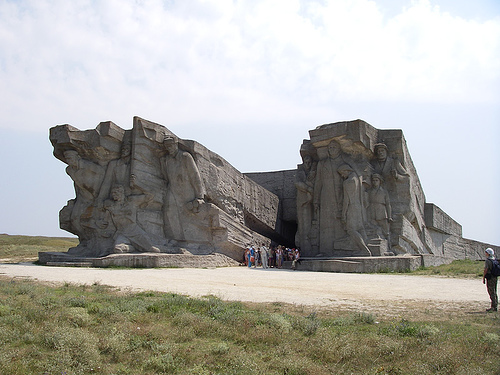

Location: Kerch, Crimean Peninsula Map
Adjimuschkay underground or Adzhimushkaysky quarries - underground quarries within the city of Kerch (named after the village of Adzhi-Mushkay), where from the second half of May until the end of October 1942, part of the troops of the Crimean Front defended against German troops. The length of the excavated passages of the central quarries is more than 8 km, many kilometers of passages are hidden under the rubble that was formed as a result of Nazi attempts to undermine the roof of the quarries. The total number of soldiers, officers, civilians (including women and children) who defended the quarry was about 13 thousand people.
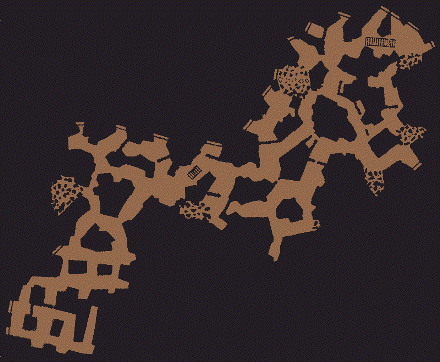
Map of underground passages
Large (Central) Adzhimushkay quarries
They are located in the
southwestern part of the village of Adzhi-Mushkay. The mine field is
elongated in plan from northwest to southeast with a strip about 800 m
long and 100 to 300 m wide (including collapsed areas). In the southern
part of the quarry, a small area was excavated and fenced off, which is
occupied by the exposition of the “Museum of the History of Defense of
the Adzhimushkay Quarries”. The thickness of the layers above the
workings is 9-10 m, the width is 4-7 m, the height is 1.6-2.7 m (up to 4
m in some places). The main part of the quarry does not have a correct
plan. A small section on the south side, the so-called "Greek Quarries",
has a planned structure. The quarries are mostly single-tier; in small
areas, stone was mined even above the main layer, forming false tiers
that had no communication with the main system. The entrances are
located along the eastern and southern borders of the mine field and for
the period of development there were more than 30 of them, of which 6
were entrances. Currently, there are several dozen entrances, mainly in
failed funnels. The total length of the passages of the Central Quarries
is about 8800 m.
Small Adzhimushkay (Jewish) quarries
They are
located 300 meters east and northeast of the Central [3]. The mine field
is elongated from north to south in a strip 630 m long and 100 to 230 m
wide. Now it represents several isolated areas. Development was carried
out in three tiers. The upper tier, the so-called "Stove quarries" runs
5-6 m above the main, middle tier. The upper and lower tiers were small
and isolated from the main one. The main part of the middle tier is the
result of unsystematic development. The height of the passages is 4-6 m
and even 8 m, the width is 4-5 m, and in some places up to 10 m.
Separate workings are often connected to each other at different levels.
Several dozen inputs are currently available. Most of them are failed
funnels and only a few have survived from the development period and are
entry points. The length of a single section of the middle tier is 10920
m, the total length of the passages of the Small Quarries is about 12300
m.
Bykovsky quarries
They are located to the north-west of the
Small Quarries, currently almost completely under the territory of the
village of Adzhi-Mushkay. The mine field is oval in plan, elongated from
the northeast to the southwest, about 480 m long and about 300 m wide.
The development was carried out in 2 tiers, the stone was lifted through
the shafts. The quarry has several sections, of different development
times. The largest section began to be developed in 1890-1891 through
the shaft, which is currently backfilled. The second section was also
developed through the currently backfilled mine shaft. It has a less
correct configuration. Developments were carried out in 1903-1914. The
third backfilled shaft is located in the southern part of the mine
field. It was the center of a small working, the modern size of which is
50 × 50 m, the development of which was carried out in the period
1913-1914. Locals call the development "Georgievsky quarries". In the
1920s-1940s, production at the third and second sites continued. In the
northwest direction, the working is interrupted by a strip of dips from
the surface, which are currently filled up. The length of the passages
is 10540 m.
Grandfather's quarries
They are located 200-250 m
northeast of the Small. The mine field is strongly elongated from the
northwest to the southeast and is about 500 m long and 50 to 110 m wide.
The development is attributed to the end of the 19th century. Currently,
there is only one entrance to the main part of the system, located in
the middle of the mine field. The rest of the entrances are filled up,
in the north and south there is a passage to small, isolated areas:
Tuboltseva, Mariichkina, Teretunskaya and Kelichkina rocks. The
entrances were named after the names of the masters. In dead ends, also
from north to south, graffiti of 19th century surnames are left. The
quarry is of considerable size, the part available for filming is 1500
m.
Vergopolsky quarries
They are located north of the
Dedushevs. There was an entrance-entrance, which was located at the
intersection of the street. Kommunarov and Pozharsky and was filled in
in 2004, as well as two pits under the development of a residential
area. Mining has been carried out since 1895 by the Kerch resident F. P.
Vergopulo. The development is in one tier, the length of the passages is
11400 m.
The use of quarries by red partisans during the
Civil War
Although in the memory of the people, the defense of
the Adzhimushkay quarries is associated primarily with the events of
the Great Patriotic War, but for the first time they became a
battlefield during the civil war in Russia. So, since the end of
1918, the red partisan detachment "Red Moles" (up to 550 people)
began to operate in them, in 1919 other detachments also arose under
the leadership of the Kerch underground city committee of the
Bolsheviks, the total number of detachments was over 1,000 fighters.
In January-May 1919, the partisans carried out over 70 combat
operations, including such daring ones as a raid on the Kerch
railway station and the Kerch Metallurgical Plant. On May 23, 1919,
partisan detachments tried to capture Kerch, but in a heavy battle,
with the support of the artillery fire of the Entente ships, the
White troops managed to push them back to the quarries with heavy
losses.
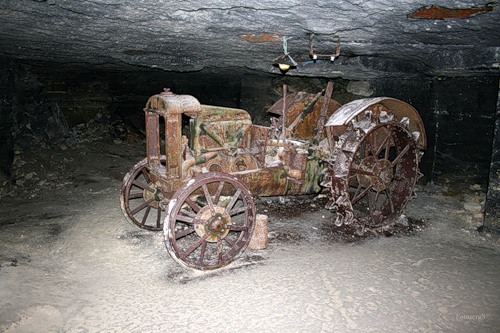
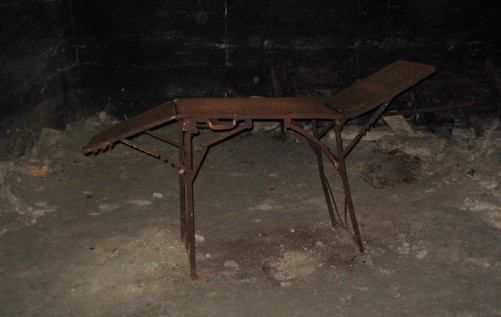
Tractor used as a power generator Remains of the make shift hospital
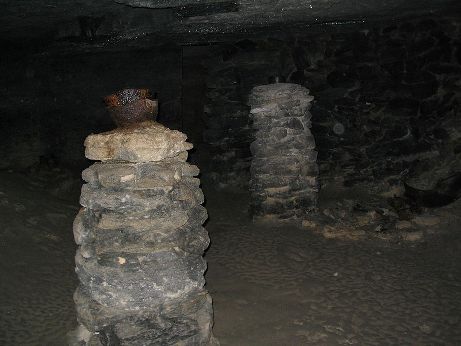
Abandoned helmets at the water collecting posts. Once the wells outside were sealed off this was the only way to get precious water.
Partisan detachments of the Crimean headquarters of the partisan
movement
The first period (November 6 - December 31, 1941) - three
detachments operated on the Kerch Peninsula under the general command of
I. I. Pakhomov, a detachment named after. V. I. Lenin (commander M. N.
Mayorov, commissar S. I. Cherkez) - in the Adzhimushkay quarries, a
detachment named after. I. V. Stalin (commander A. F. Zyabrev, died on
November 12, 1941, S. M. Lazarev, commissar I. Z. Kotko), a detachment
of the Mayak-Salyn region (commander I. G. Shulga, commissar D. K.
Tkachenko) in the Karalar quarries. K. M. Simonov wrote an essay about
them in March 1942 in the Red Star.
Defense of the remnants of
the troops of the Crimean Front
The second period falls on the
spring-autumn of 1942. During Operation Bustard Hunting in May 1942, the
troops of Nazi Germany and Romania launched an offensive on the Kerch
Peninsula and captured Kerch on May 16. The troops of the Crimean Front,
defending the city, were forced to evacuate to the Taman Peninsula. Part
of the troops (the remnants of the 83rd Marine Brigade, the 95th Border
Detachment, the Yaroslavl Aviation School, the Voronezh School of Radio
Specialists and other units - more than 10 thousand people in total),
covering the withdrawal and crossing of the main forces, was cut off and
took up defense in the Adzhimushkay quarries. Part of the local
population took refuge there.
In the Central quarries, the
defense was led by Colonel P. M. Yagunov, senior battalion commissar I.
P. Parakhin and Lieutenant Colonel G. M. Burmin, in the Small (Jewish)
quarries - Lieutenant Colonel A. S. Ermakov, Senior Lieutenant M. G.
Povazhny, battalion commissar M. N. Karpekin. The Nazis surrounded the
quarries with rows of barbed wire, blew up and blocked the entrances,
pumped smoke into the underground adits, and made collapses. Assumptions
about the use of chemical weapons by the German troops against the
chemical weapons hiding in the quarries have not yet been confirmed; the
Soviet side has never made accusations of such use at the official
level. From the first days, the main need of the defenders was water. At
first, the soldiers constantly made sorties to the surface (using more
than a thousand exits from the quarries) to draw water from the wells,
despite the fact that the wells were guarded by the Germans and each
sortie ended in heavy losses. Then the German command decided to fill
the wells with the corpses of Soviet soldiers and the remains of broken
military equipment. Then the defenders created special detachments to
collect water from the walls of the cave, the soldiers sucked water out
of the limestone through the cuts of the German telephone cable and
poured it into flasks. Thus, one person collected up to 800 ml of water
in two hours. Also, a well with a depth of more than 16 m was dug in the
cave. Despite the acute shortage of water, food, medicine, ammunition,
the besieged made sorties.
Presumably, the last battle of the
Adzhimushkais took place on October 30, 1942, as a result of which the
quarries were completely captured by the Nazis. The few survivors of the
battle fell into German captivity, only a few were able to survive it.
Burmin G.M and battalion commissar Parakhin I.P. were tortured in a
concentration camp.
Thousands of Soviet fighters and civilians
died in battles, as well as from wounds, collapses, suffocation and
hunger. Despite the fact that the heroic defense of the Adzhimushkay
quarries did not bring an immediate victory to the Soviet side, it, like
other defensive operations of the initial period of the war, made it
possible to tie up significant Wehrmacht forces, disperse them across
the territory of the USSR, and restrain the offensive impulse of the
German army.
In the autumn of 1943, the German-Romanian occupiers
committed a new crime in the Adzhimushkay quarries: over 14,000
civilians of the Crimea and those evacuated from the Taman Peninsula
were shot dead.
In November 1943, the area of the Adzhimushkay
quarries was liberated by units of the 56th Army during the
Kerch-Eltigen landing operation.
False detachment "Red
Stalingrad"
In 1943, the SD authorities, having recruited Moiseev, a
former fighter of the Crimean Front, decided to conduct an operational
game to identify Soviet partisans in the quarries. From the memorandum
of the NKGB of Crimea to the Commissar of State Security of the USSR
Merkulov on the state of work on the search for German agents and other
state criminals: the same area, to eliminate them.
In October of
the same year, Moiseev and his people shot two partisan liaisons who had
come to them from a neighboring detachment to join forces. In November
1943, during the liberation of Kerch, the Moiseevites left the quarries
to the Soviet troops. The members of the detachment were sent to the
filtration camp of the village of Akhtanizovskaya in the Krasnodar
Territory. In the camp, Moiseev once again instructed his people to stay
in one line - we are partisans who fought for the Motherland behind
enemy lines. The commander himself managed to successfully pass the
filtration check and from the camp he went to the disposal of the North
Caucasian Military District in Rostov. There he even received a
three-month deferment from mobilization and the opportunity to go to his
native village. During this time, the investigators checked a lot of
materials, studied interrogation materials, testimonies of witnesses,
worked with people and documents. In the same 1944, Moiseev was exposed
and sentenced to death by the Military Tribunal of the troops of the
NKVD of Crimea. 11 SD agents were arrested, recruited by a false
commander of a false partisan detachment.
One of the first who began searching in the catacombs
was the Kerch journalist Vladimir Birschert (Spark magazine, 1961, No.
35, No. 48). Military historian Vsevolod Valentinovich Abramov made his
contribution.
In the 1960s, students of the Kerch School No. 17
named after Vera Belik began to search in the catacombs, who a few years
later managed to make a number of serious finds. A school museum was
created.
It turned out that M. G. Povazhny survived in captivity
and lives in Kerch, and there were other surviving participants in the
defense.
In January 1966, the Adzhimushkay branch of the Kerch
Historical and Archival Museum was established. All search work in the
catacombs was headed by the head of the museum branch, Sergei
Mikhailovich Shcherbak, one of the organizers of the military-historical
conference dedicated to the 25th anniversary of the defense of
Adzhimushkay.
In 1972, the first complex expedition began to work
in the catacombs (Crimean speleologists, sappers and signalmen, a group
of the Poisk detachment from Odessa and enthusiasts from Kerch). The
purpose of the expedition is to find headquarters documents of military
units, documents of the party organization of the underground garrison.
The expedition was "speleological, the highest category of difficulty,
work in the conditions of soil of the 4th-5th category (numerous
landslides, talus), with explosive objects in conditions of mine
lighting ...". They even found 152- and 122-mm shells, mines, grenades
and hundreds of unexploded 45-mm shells. The results of the first
expedition were modest.
In the summer of 1973, the most numerous
expedition worked, including the military historian V.V. Abramov. Great
work was done by defense veterans S.S. Shaydurov from Ordzhonikidze and
F.F. Kaznacheev from Baku. With their help, the central adit of the
Great Quarries was accurately determined - the main landmark of all
defense sectors. Treasurers pointed out where the main radio was. In
total, this expedition had about 150 items found. But one of the most
significant finds of the 2nd season were 2 half-burnt gas-smoke bombs
and a thin-walled body of a smoke or chemical grenade that fell apart
into fragments. The analysis of the substance of the checkers was
difficult (30 years have passed). The expedition members suggested that
the Nazis used asphyxiating poisonous substances, letting them go with
smoke, for which such gas-smoke bombs were made, but objective evidence
could not be found. It should be noted that the standard smoke bombs
themselves, when used against an enemy underground, can be effective
under certain circumstances.
In 1974, the first detachment of
Uralians arrived in Adzhimushkay - students of the Sverdlovsk Mining
Institute, led by MP Vakhrushev, Candidate of Historical Sciences.
Starting from 1975, a combined detachment from the cities of the
Chelyabinsk region (Miass, Zlatoust, Chebarkul) worked, as well as a
detachment from Lipetsk.
Enthusiasts from the Miass detachment
(1975-1976) found two adits (a dead end cut off by a dead blockage) and
the headquarters of the 1st battalion. The main attention during the
search was given to the area of the underground well. It was he who was
the last base of the soldiers of the garrison. They could not be far
from the water source. They also searched in the area of
\u200b\u200bdeployment of the 3rd battalion in the western part of the
quarries.
In 1982, another surprise was discovered in the
quarries: it turned out that the underground well was mined (by Soviet
grenades).
The student team of Rostov University has been
involved in the work since 1983. It is headed by a student, future
journalist V. K. Shcherbanov.
In 1987, searchers dug up a safe
with documents in the quarries. Then it was possible to find out another
120 names of the soldiers of the underground garrison. To date, official
historians know 323 names. Search engines call another number - 1200.
In total, 13 expeditions were carried out until 1987. Since 1989,
research in the Adzhimushkay quarries was led by V. V. Simonov.
After the end of hostilities, mine clearing of the
quarries began (which continued for several decades). The demining work
was headed by Major General O. B. Rogozhkin, of the sappers the most
distinguished were Majors N. Nadtochia and M. Yakovlev, Senior
Lieutenant A. Kushnir, Junior Sergeant V. Averin, as well as privates R.
Sakhretdinov and L. Chankov.
In 1966, an underground museum of
the defense of the Adzhimushkay quarries was created, in 1982 a memorial
to the heroes of the Adzhimushkay quarries was opened. On May 15, 1983,
the two millionth visitor visited the underground museum.
The
feat of the underground garrison was not appreciated by the USSR
Ministry of Defense. Despite letters from the public, none of its
participants received the title of Hero of the Soviet Union, even its
brightest participants - the commander of the garrison Yagunov P.M., the
commissar of the garrison Parakhin I.P., Burmin G.M. Also, the
underground fortress of the Adzhimushkaysky quarries was not awarded the
title of "Hero-Fortress" - the highest degree of distinction, as
happened with the Brest Fortress.
On February 20, 1976, in honor of the heroic soldiers
of the Soviet Army and the Crimean partisans who fought during the Great
Patriotic War in the Adzhimushkay quarries, the asteroid discovered on
May 9, 1972 by T. M. Smirnova in Nauchny was given the name 1903
Adzhimushkaj.
Publications
The first scientific publications
appeared in the Military Historical Journal (1962, No. 7, No. 8). The
Vokrug Sveta magazine regularly published articles on the work of the
expeditions of 1972-1974, and the article “Second Battalion
Headquarters” was published in No. 12 for 1988 about the magazine’s
expedition, during which some documents of the garrison were found.
There were also two reports by V. I. Molchanov in Pravda on April 15,
1973 and February 20, 1974.
1970 - "Soldiers of the Underground"
by Nikolai Arsenyevich Efremov. Memoirs of a direct participant in the
defense.
1975 - "In the catacombs of Adzhimushkay" compiled by B.
Serman from the Tavria publishing house. Documents, memoirs, articles.
1987 - "Valor is immortal" G. N. Knyazev and I. S. Protsenko from the
publishing house "Politizdat". At that time, only 323 soldiers of the
underground garrison were known to some extent.
In fiction
Poet Ilya Selvinsky and writer Sergei Smirnov were among the first to
write about Adzhimushkay.
1948 - novel "Honor from a young age" by A.
A. Perventsev.
1949 - the story "The Street of the Youngest Son" by
L. A. Kassil.
1964 - "The Underground Fortress" by S. S. Smirnov
(from the collection "Stories about Unknown Heroes").
1974 - "The
Fortress of Soldiers' Hearts" by Andrey Ioannikevich Pirogov.
1981 -
"The Height of Adzhimushkay" by I. I. Miroshnikov (from the collection
"Fire-winged Tribe" (poetry)).
1984 - the story "Two of Twenty
Million" by A. Ya. Kapler was filmed in 1986 under the title "Descended
from Heaven".
2015 - the story "Light in the Darkness (dedicated to
the memory of the forgotten heroes of Adzhimushkay)" by O. K.
Shevchenko.
Kambulov Nikolay Ivanovich: the stories "The Underground
Garrison" (the first edition was called "The Light in the Catacombs"),
"Thirteen Shards", "Adzhimushkayskaya Notebook", the novel "The Breeder
Has Not Come Yet".
To the cinema
1986 - Descended from Heaven
(USSR) directed by N.V. Troshchenko. Screen version of the novel by A.
Ya. Kapler "Two out of twenty million" (1984).
In 2015, aspiring
screenwriter Roman Tenzin published on the Internet the script for the
full-length feature film “Adzhimushkay. Underground garrison. To date,
the script has not been filmed.